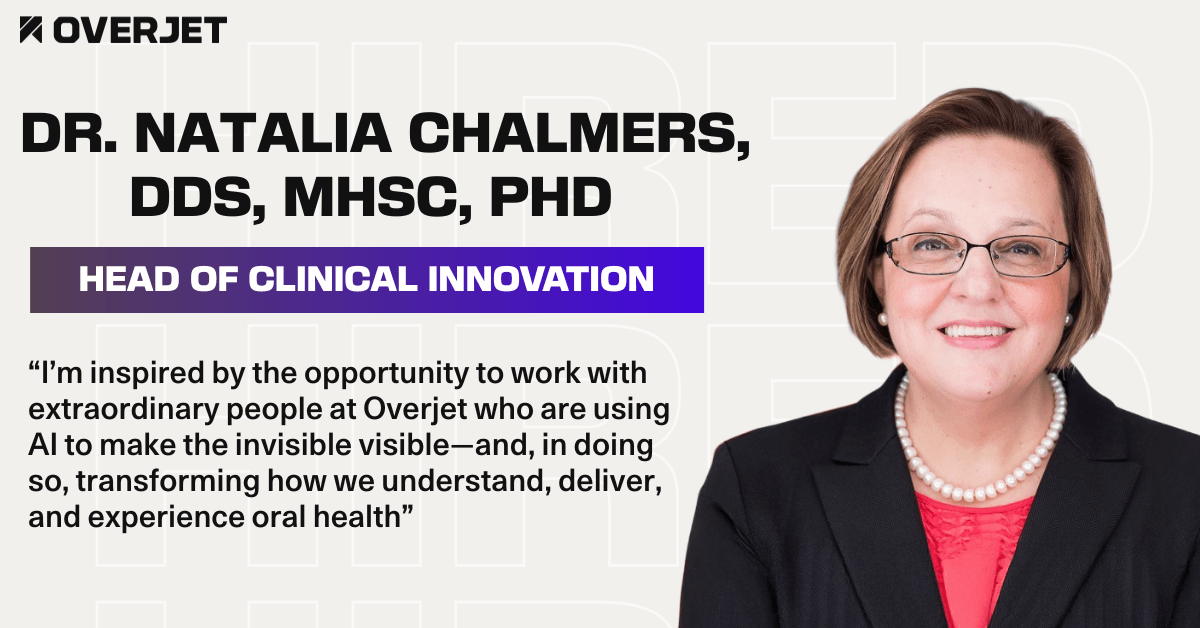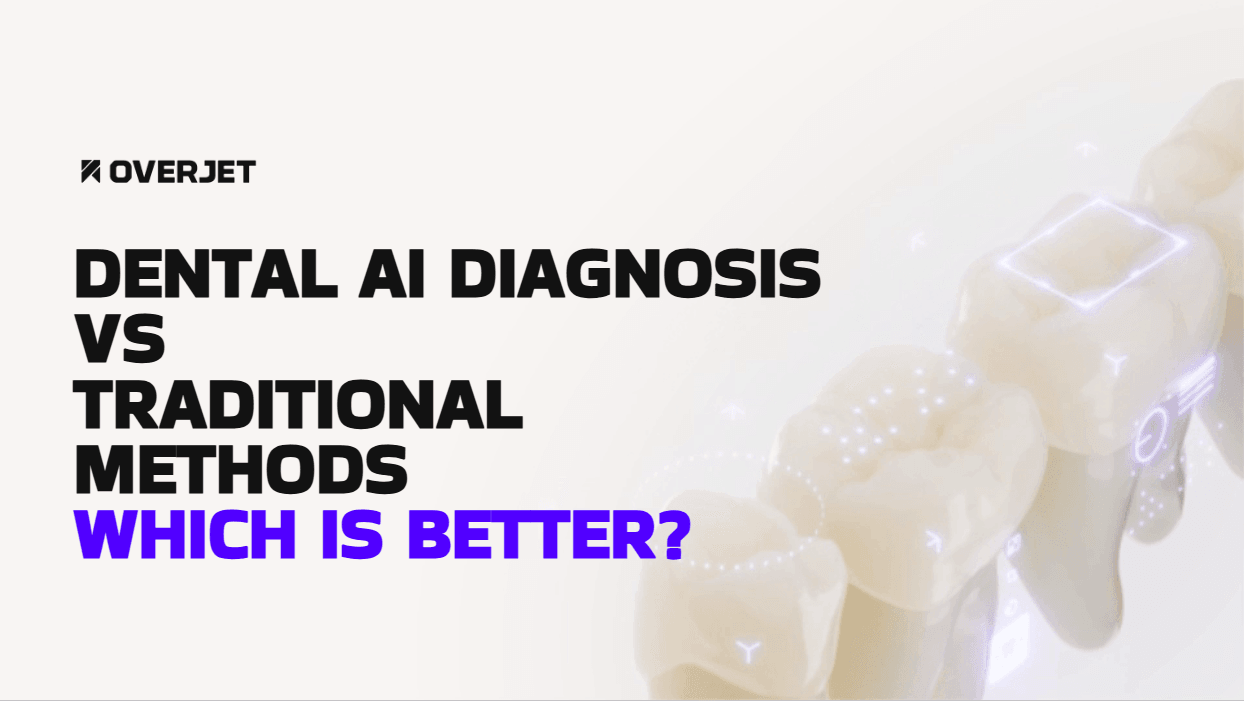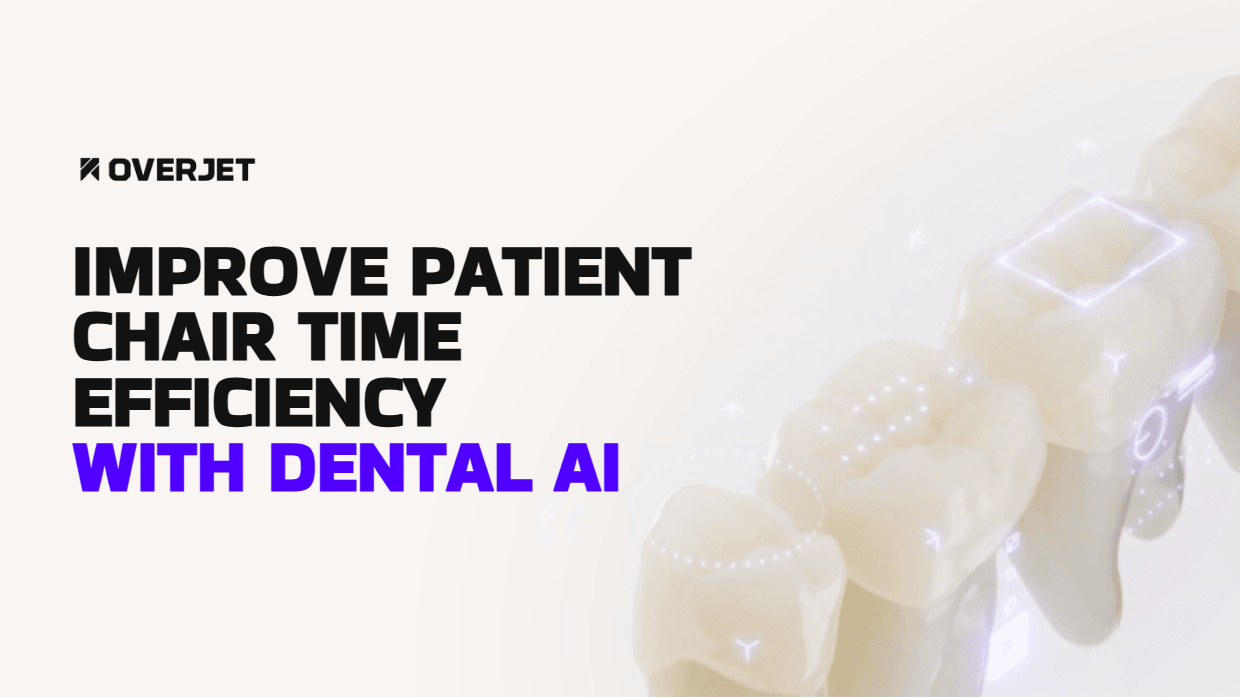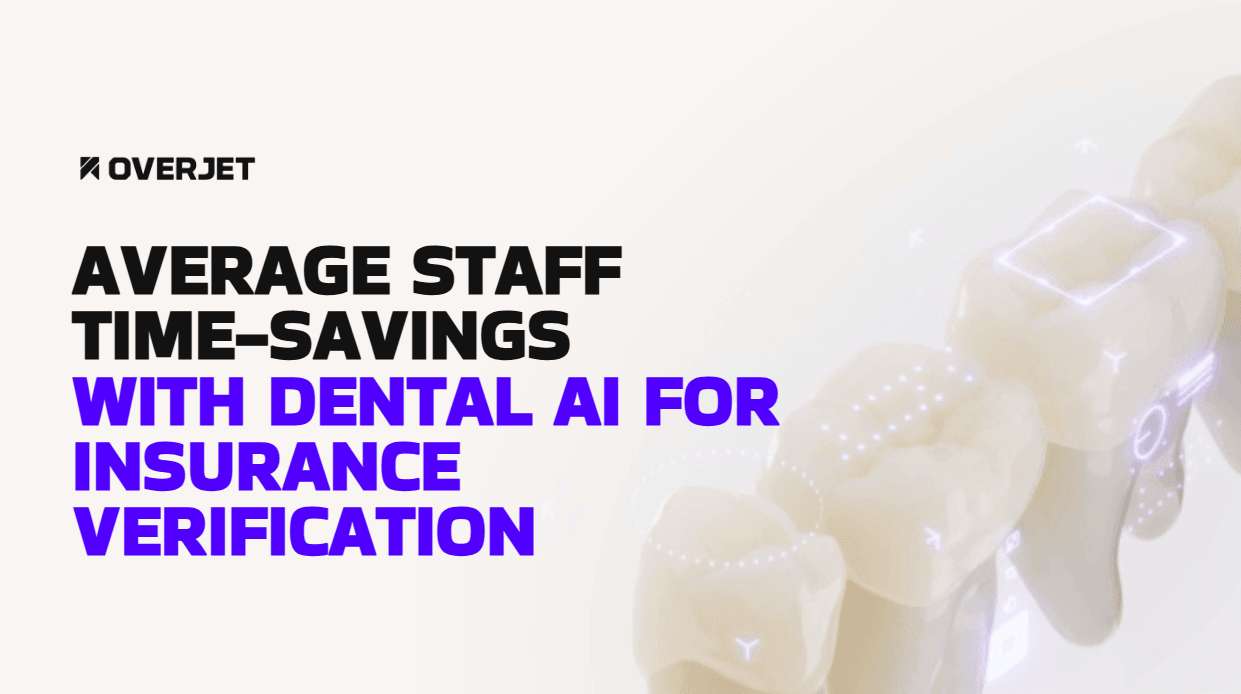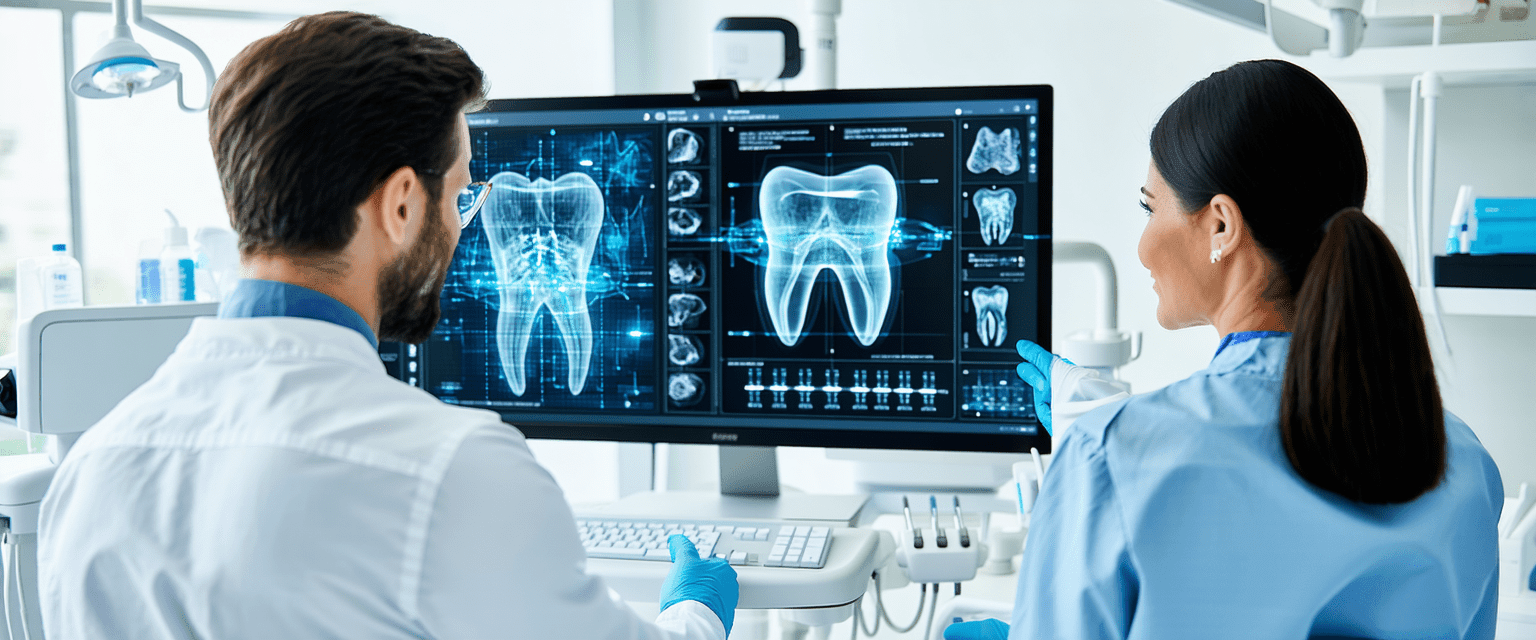Dental practice profit margins typically range between 30-40% of total revenue, with specialty practices often achieving higher percentages due to their focused service offerings and premium procedures. This metric represents what remains after subtracting all operating expenses from collections, serving as the primary indicator of practice financial health.
Several factors influence these margins, from overhead management and payer mix to scheduling efficiency and case acceptance rates. This guide examines current benchmarks across different practice models, breaks down the key variables affecting profitability, and provides actionable strategies for improving your practice’s financial performance in 2025.
Explore Overjet's Dental AI Software
Average Dental Practice Profit Margin in 2025
Most dental practices maintain profit margins between 30% and 40% of total revenue, though specialty practices often achieve higher percentages. General dentistry typically falls within this range, while orthodontics and oral surgery frequently exceed 40% due to higher case values and specialized procedures.
However, some sources indicate that both general practitioners and specialists may experience overhead as high as 75%, resulting in only a 25% profit margin. This suggests that profit margin ranges may vary more than presented, depending on the practice model and other factors.
Profit margin represents what remains after subtracting all operating expenses from collections. This includes everything from staff salaries and lab fees to rent and equipment costs.
General Dentistry
General practices usually see margins between 30-38%, depending on their case mix and operational efficiency. Practices that balance routine cleanings with higher-value restorative work tend to perform better financially.
The key difference lies in procedure scheduling—practices that fill their day with only cleanings will struggle compared to those mixing preventive care with crowns, fillings, and cosmetic procedures.
Orthodontics
Orthodontic practices often achieve 40-50% margins because treatment plans span 18-24 months with predictable payment schedules. Each case generates substantial revenue over time, making the initial consultation and setup costs more manageable.
However, orthodontic practices require significant upfront investment in specialized equipment and longer treatment coordination periods.
Pediatric Dentistry
Pediatric practices typically maintain 32-42% margins, influenced heavily by insurance reimbursement rates and the extra time required for young patients. Many procedures take longer due to patient cooperation challenges and specialized techniques.
Successful pediatric practices often supplement insurance revenue with membership programs for families without dental coverage.
How Profit Margin Is Calculated in Dentistry
Dental profit margin equals net profit divided by total collections, multiplied by 100. Net profit represents what’s left after paying all practice expenses, from payroll to supplies to facility costs.
Total collections include all payments received from patients and insurance companies for completed treatments. This differs from production, which represents the value of work performed regardless of payment status.
Collections Minus Overhead
Collections represent actual money received, not just services rendered. A practice might produce $50,000 worth of dentistry in a month but collect only $42,000 due to insurance processing delays or patient payment plans.
Overhead encompasses every business expense except owner compensation. This includes staff wages, benefits, supplies, lab fees, rent, utilities, equipment payments, and insurance premiums.
EBITDA vs. Owner Salary
EBITDA (Earnings Before Interest, Taxes, Depreciation, and Amortization) measures practice profitability separate from what the owner pays themselves. This distinction becomes crucial when evaluating practice performance or preparing for sale.
Owner salary compensates the dentist for clinical work, while EBITDA reflects the practice’s ability to generate profit as a business entity. Banks and buyers focus heavily on EBITDA when assessing practice value.
Current Benchmarks by Practice Model
Practice structure significantly affects profit margins, with each model presenting distinct financial characteristics. Solo practices often achieve higher per-dollar margins, while larger organizations benefit from shared costs and bulk purchasing power.
Location, patient demographics, and local competition also influence these benchmarks considerably.
Solo Private Practice
Solo practitioners typically achieve 35-42% margins when efficiently managed, maintaining complete control over clinical decisions and fee structures. These practices can quickly adapt to market changes and implement new technologies without committee approvals.
The downside involves bearing full responsibility for all business decisions, from staffing to marketing to equipment purchases. This can limit growth potential and create operational bottlenecks when the owner is unavailable.
Group or DSO-Affiliated
Group practices and DSO-affiliated locations often maintain 28-35% margins, reflecting shared overhead costs and centralized administrative functions. These arrangements provide access to bulk purchasing, shared marketing expenses, and professional management support.
The trade-off involves reduced autonomy in clinical and business decisions, plus potential conflicts between corporate profit goals and individual practitioner preferences.
Multi-Site Practices
Multi-location practices can achieve 32-40% margins when properly managed, spreading administrative costs across multiple revenue streams. Successful expansion requires careful market analysis and strong operational systems.
Administrative complexity increases significantly with each additional location, demanding sophisticated management systems and clear operational protocols.
Overhead Targets That Protect Net Income for Dentists
Controlling overhead expenses directly impacts profit margins, with successful practices monitoring key expense categories as percentages of total revenue. Industry data provides guidance for evaluating practice efficiency and identifying improvement opportunities.
Most profitable practices maintain total overhead between 60-70% of collections, leaving 30-40% as profit margin.
It is worth noting that some sources cite average dental practice overhead at 55-65%, while others suggest a broader range of 60-80%. This indicates that there is variation in how overhead is calculated and reported across the industry.
Staff Compensation: Typically 25-30% of revenue, including wages, benefits, and payroll taxes for clinical and administrative team members
Lab and Supply Costs: Combined target of 10-14% of revenue, with dental supplies around 5-6% and lab fees at 6-8%
Facility Expenses: Rent, utilities, and equipment costs totaling 8-12% of revenue, including lease payments and maintenance contracts
Professional Services: Generally 3-5% of revenue for marketing, continuing education, and professional consultations
Factors That Shrink or Grow Dental Practice Revenue
Revenue optimization depends on understanding key variables that influence practice income, from scheduling efficiency to fee structure management. Small improvements across multiple areas often produce significant cumulative effects on overall profitability.
Modern dental practices increasingly rely on technology solutions that enhance both clinical outcomes and operational efficiency.
Payer Mix and Fee Schedules
Insurance reimbursement rates typically fall 20-40% below private pay fees, making payer mix a critical factor in practice profitability. Practices with higher percentages of private-pay patients generally achieve better margins, though insurance participation provides patient volume stability.
Fee schedule reviews help ensure pricing remains competitive while supporting target profit margins across different patient segments.
Chair Utilization Rate
Optimal chair utilization—typically 75-85% during operating hours—maximizes revenue from fixed facility costs. Efficient scheduling systems minimize gaps between appointments while allowing adequate time for quality patient care.
Advanced scheduling software identifies patterns and optimizes appointment types to improve both productivity and patient satisfaction.
Patient Retention and Recare
Established patients generate significantly more revenue than new patient visits over their lifetime relationship with the practice. Effective recall systems maintain consistent appointment schedules while identifying opportunities for additional treatment.
Patient education tools significantly improve treatment acceptance rates by helping patients visualize their oral health conditions and understand recommended treatments. Overjet’s AI-powered imaging platform provides clear, annotated visuals that make complex dental conditions easier for patients to comprehend.
Five Actionable Ways to Improve Profit Margin Next Year
Strategic improvements to practice operations can meaningfully impact profit margins within 12-18 months. Focus on changes that address both revenue growth and expense control simultaneously for maximum effect.
Technology investments often provide the highest return on investment when they improve both clinical outcomes and operational efficiency.
1. Optimize Scheduling Efficiency
Block scheduling groups similar procedures together and minimizes schedule gaps through automated appointment reminders and waitlist management. Strategic scheduling can increase daily production by 15-25% without adding operating hours.
Morning hygiene blocks followed by afternoon restorative appointments maximize both preventive and treatment revenue streams while improving workflow efficiency.
2. Increase Case Acceptance With Visual Aids
Patient education significantly improves treatment acceptance rates, with visual aids increasing case acceptance rates compared to verbal explanations alone. When patients can see their oral health issues clearly illustrated, they’re more likely to proceed with recommended treatments promptly rather than delaying care.
Overjet’s AI-enhanced imaging provides clear, annotated visuals that help patients understand their conditions and treatment options more effectively than traditional explanation methods.
3. Reduce Insurance A/R Days
Streamlined insurance claim processing reduces accounts receivable days from submission to payment. Automated claim review systems identify potential issues before submission, reducing rejections and accelerating payment cycles. Overjet’s automated workflows catch common claim problems early, helping practices avoid the time-consuming process of claim resubmission and follow-up calls with insurance companies.
4. Expand High-Margin Procedures
Evaluating current service mix helps identify opportunities to add profitable procedures that align with existing clinical expertise. Cosmetic dentistry, implant restoration, and sleep apnea treatment often provide higher margins than routine restorative work.
Continuing education investments in high-margin procedures typically pay for themselves within 6-12 months through increased case values and expanded treatment options.
5. Control Variable Supply Costs
Inventory management systems prevent overstocking while ensuring adequate supplies for daily operations. Volume discounts with suppliers and group purchasing arrangements reduce per-unit costs without compromising quality.
Regular expense audits identify opportunities for cost reduction that don’t impact patient care quality or team productivity.
How AI Automation Increases Average Revenue of Dental Practice
Artificial intelligence transforms dental practice operations by improving diagnostic accuracy, streamlining administrative processes, and enhancing patient communication. These improvements directly impact both revenue generation and expense control.
Modern AI solutions integrate seamlessly with existing practice management systems, providing immediate benefits without disrupting established workflows.
Diagnostic Accuracy and UCR Alignment
AI-enhanced diagnostic tools improve treatment plan accuracy and support appropriate coding for insurance submissions. Overjet’s FDA-cleared detection capabilities identify conditions that might otherwise go unnoticed, ensuring comprehensive treatment planning and proper reimbursement.
Accurate diagnosis and coding reduce claim rejections while maximizing legitimate reimbursement for services provided, directly impacting practice revenue.
Automated Claim Review and Payment Cycle
Automated claim processing reduces administrative burden while accelerating payment cycles from insurance companies. Advanced systems identify potential claim issues before submission, reducing rejection rates and minimizing time spent on claim follow-up.
Practices using automated claim review typically see a significant reduction in accounts receivable days, improving cash flow and reducing administrative costs.
Predictive Recall Analytics
AI-powered analytics identify patients at risk of missing recall appointments and suggest optimal timing for recare outreach. Advanced systems analyze patient behavior patterns to optimize communication strategies and appointment scheduling.
Predictive analytics help maintain consistent recall participation rates, ensuring steady revenue from preventive services while identifying treatment opportunities early in the disease process.
Profit Margin Benchmarks and Practice Valuation Multiples
Practice profit margins directly influence valuation multiples when selling or seeking financing for expansion. Buyers and lenders evaluate margin consistency and growth trends when determining practice value and loan terms.
Strong margins indicate effective management and operational efficiency, making practices more attractive to potential buyers and lending institutions.
EBITDA Multiples by Margin Tier
Practices with margins above 40% typically command higher valuation multiples compared to those below 30%. Consistent margin improvement over time demonstrates management competency and growth potential to prospective buyers.
Specialty practices with higher margins often receive premium valuations due to their specialized expertise and typically more stable patient relationships.
Impact on Lending Terms
Banks typically require practice margins above 25% for acquisition financing, with better terms available for practices demonstrating margins above 35%. Strong margins indicate the practice’s ability to service debt while maintaining operational stability.
Lenders also evaluate margin trends over time, preferring practices that show consistent profitability and growth patterns rather than volatile financial performance.
Putting It All Together for Sustainable Growth
Sustainable profit margin improvement requires a balanced approach addressing both revenue optimization and expense control. Focus on changes that enhance patient care quality while improving operational efficiency for long-term success.
Technology investments that improve both clinical outcomes and administrative efficiency provide the highest return on investment and support sustainable growth. Regular financial analysis and benchmarking against industry standards help identify opportunities for improvement while ensuring practices remain competitive in their markets.
The key lies in implementing changes systematically rather than attempting dramatic overhauls that disrupt established patient relationships and team dynamics.
Book a Demo to See Overjet in Action
Discover how Overjet’s AI-powered solutions can improve your practice’s profit margins through enhanced diagnostic accuracy, streamlined insurance processes, and improved patient communication. Book a demo to see how leading practices are using artificial intelligence to optimize their operations and increase profitability.
Ready to See Overjet's Dental AI in Action?
Frequently Asked Questions (FAQs)
What profit margin indicates a healthy dental practice?
A healthy dental practice typically maintains profit margins between 35-40%, though this varies by specialty and practice model. Margins consistently above 30% indicate effective operational management and financial stability.
How do PPO contracts affect dental practice profit margins?
PPO fee schedules typically reduce per-procedure revenue by 20-40% compared to private pay rates, requiring higher patient volumes to maintain target profit margins. Successful practices balance PPO participation with private pay patients to optimize overall profitability.
What is the difference between gross profit and net profit in dental practices?
Gross profit represents total collections minus direct costs like lab fees and supplies, while net profit accounts for all operating expenses including staff salaries, rent, utilities, and equipment costs. Net profit margin provides the most accurate picture of practice profitability.



